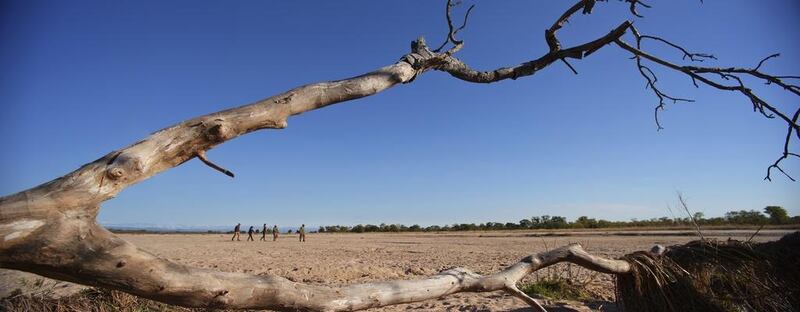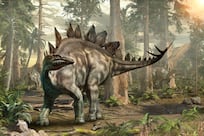Partway through wolfing down a moist slab of carrot cake, I suddenly pause, fork hovering in mid-air. Far across the dry riverbed opposite, a man-sized lizard appears to be climbing a near-vertical bank. I grab my binoculars. "Oh yes, they do that all the time," says Brian Mukumbutu, our guide. "Look at those claws," he continues nonchalantly, as the monitor hauls itself onto flat land and saunters off into shrubbery.
Carrot cake and monitor lizards seem unnatural companions, but on a high-end African safari, almost anything is possible. Here in Zambia’s South Luangwa National Park, I’m combining the comforts of a luxurious Norman Carr safari with the out-there experience of walking amid the wildlife. Even with their sharp, splayed-fork claws, these lizards are, frankly, of minimal concern. Right now, lions are looming large in my thoughts.
Zambia isn’t the most obvious safari destination, but most cognoscenti agree it’s among the best. Remoteness and relatively few visitors mean its parks tend to feel – and mostly are – wilder than many better-known rivals.
Watered by the Luangwa River and several seasonal tributaries, the 9,059-square-kilometre South Luangwa is the country’s most famous national park. Bordered in the west by Muchinga Escarpment, the vast Luangwa Valley is sparsely populated because its great river, one of the most untouched in southern Africa, floods spectacularly each year and re-sculpts the landscape. Four of the continent’s “big five” reside here. The park’s reputation rests on particularly good sightings of leopards.
Born in Mozambique in 1912, the late Norman Carr became something of an elder statesman in the African safari world. Starting as an “elephant control officer” with first-hand, first-rate bush knowledge, he graduated to running Rhodesia’s and eventually Zambia’s national parks while training wardens and rangers. By the 1950s, he’d already realised that local involvement and participation was key to sustaining the continent’s wildlife – obvious now, but radical in its time.
Carr’s old-school mystique pervades the safari operator’s properties. He was famed for his “pet” lions, and you notice pictures of them almost lolling at his feet as he shaves or strolls around camp. Carr also pioneered the concept of a walking safari, where plucky guests came armed with cameras rather than rifles. Today, while the new Chinzombo Camp anchors the Norman Carr Safaris operation, with striking villas and more than a hint of “glamping”, its simpler satellite camps offer reasonable comfort in tribal huts. And it’s these that form the backbone for a series of immersive walking safaris across truly wild, lion-populated country.
After finishing cake and coffee in a shady grove of ebony trees, we set off on a short pre-dinner stroll. Nsolo Camp’s four chalets are perched on stilts overlooking the Luwi River. Mukumbutu leads us wide of a water hole occupied by a sole hippo that occasionally yawns, its gaping jaws opening comically wide. “That’s a threat gesture, and he’s displaying his strength; they’re very territorial,” he says. The hippo’s honking – a fading-away chortle – trails us as we head across the river into bush country.
We’re being neatly primed for the following day’s eight- or nine-kilometre hike. Within metres of leaving Nsolo and its comforts, you’re really in the wild. Mukumbutu urges us to stay close together, preferably in single file. Isaiah, our rifle-toting guard, brings up the rear. “Animals really hate being surprised. It’s fear,” Mukumbutu continues. “So we usually keep wide of thick vegetation.”
It becomes apparent that guides such as Mukumbutu make newcomers such as myself seem myopic: he reads the terrain and its resident wildlife like a map. Honey badger burrows, holes dug by aardvarks, the odd clump of white hyena dung. White? “They eat bones… full of calcium,” says Mukumbutu.
We pass several so-called “sausage trees” whose elongated hanging fruit is widely eaten by various animals. Antelopes in particular gorge on its fallen flowers, so stealthy leopards have learnt to wait patiently up its branches. Up I peer. “The fruit’s more dangerous,” chuckles Mukumbutu, picking one off the ground to show how heavy they are – potentially lethal if falling on one’s head.
We end our first foray enjoying sundowners on the dry riverbed where chairs, lanterns and a roaring fire await us. Back at camp over dinner, the manager Philemon Banda speaks with great conviction on Zambia’s conservation efforts. The 1970s were a dark period in Luangwa’s history – poachers completely wiped out the park’s black rhino population and elephants were decimated. Then things turned; the park was better managed, the elephant population in particular grew and now, through a combination of regular aerial surveys and many local informants, Luangwa’s wildlife is thriving once again. But there are still no rhinos.
By 7am the next morning, we’re off again. Almost immediately, Mukumbutu spots the tracks of hyenas, wild dogs and even a leopard. Hyenas, he says, often follow dogs, which are superb hunters but frequently leave enough behind for scavengers. We shadow the Luwi River, crossing its bleached sandy bed several times through a mix of savannah, shady woodland and strands of tall elephant grass. Later in the season, this grass dies back, improving visibility; by September, as animals congregate around fewer water sources, sightings are usually at their best.
Reaching a small gully alongside the riverbank, we slow right down and approach cautiously. “Last year at this very spot, a lioness sprang up – she was protecting her cubs. You never know what to expect,” says our guide. In truth, we’re all hoping for the proximity of lions; this is part of the thrill of bush walking.
We pause about 9am for tea and biscuits. Then, atop a picturesque section of riverside cliffs, we gaze down at a bloat of wallowing hippos. Measured by human fatalities, they’re the continent’s most dangerous animal, simply because both tend to cluster around rivers, making incidents common. “And Luangwa has one of Africa’s densest populations,” Mukumbutu says.
Minutes later, I practically leap out of my skin. Almost by my heels, an unseen bird startles us by abruptly taking flight and clucking noisily. It’s a francolin (sometimes known as the adrenaline bird, though it resembles a humble partridge). Absurdly, this proves the scariest moment of my walk.
By about 10.30am, Luwi Camp’s luxuriant grove of mahogany trees comes into view. We eat brunch – meatballs, quiche and salad – at a long communal table and laze away the midday heat before strolling up to a hide perched above a pretty oxbow lake. As the Luangwa Valley dries in winter and its rivers shrink or dry, these distinctive lakes remain vital water sources.
A huge crocodile basks in the sun, while yet more hippos wallow contentedly among water lettuce. Luwi has a particularly rustic air (my chalet and its roof are built around a tree rooted right behind the bed), mainly because its natural materials are largely dismantled at the season’s end, part of a minimum-impact philosophy. Over dinner, the manager Frank recalls his first experience here. Lions passed through camp in the middle of the night: “They were just feet away. You could hear them breathing – it was incredible.”
The next morning over breakfast porridge, a camp guard tells us he’d heard lions roaring at dawn and the alarm calls of impalas. But although visually, at least, the lions are surprisingly elusive, leopards prove more obliging. We set off by Land Rover for the main Chinzombo Camp and agree to an extended safari drive en route. As we meander toward the Luangwa River, gorgeous slanting amber light fires a seemingly endless plain dotted with sturdy leadwood, tamarind and mopane trees.
Isaiah spots the leopard, a beautiful female sitting perfectly camouflaged in tawny grass, seeming to gaze at distant grazing puku antelope. We edge closer. Mukumbutu is surprised at how unbothered she seems. Then we notice the reason for her lingering. Behind us, up in a tree, lies a dead impala – her kill – but another male leopard lurking nearby is trying to steal it. Our arrival complicates the dynamics. After eyeing us cautiously, he suddenly skulks away. Seconds later, she bounds over, scrambles up the tree and drags her kill even higher to devour it in peace.
Still excited by this extraordinary encounter, we eventually reach Chinzombo and its welcoming posse of beaming staff by taking a tiny boat across the Luangwa. Fronted by a meadow-like expanse of green, the lodge overlooks a sweeping bend of the river. Being the recently rebuilt heart of the Norman Carr Safaris operation, it’s considerably more comfortable and luxurious than their bush camps; indeed some guests venture no farther. The bar (with the huge bleached lower jaw of a hippo resting on the counter), lounge and informal dining areas all merge in an open-sided pavilion with a terrace and fire pit.
Six spacious villas boasting rather masculine interiors – combining heavy-duty canvas, traditional thatch and leather fittings – faintly resemble an elaborate marquee. Vast beds are screened with tent-sized mosquito nets; another “room” with a free-standing bathtub and twin sinks doubles as a dressing area. Roll-up walls open onto a spacious raised deck with a sofa underneath the shaded porch. Out in the sun, you can choose between a little plunge pool and a sunken lounge area with simple banquettes. There’s no fence between you and whatever wildlife may wander by below.
Just after I check in to my villa, other guests have to wait a few minutes for munching elephants to move on. Later, as I gaze from my plunge pool, a troop of baboons amble by yards away, grooming each other while foraging for seeds. Luangwa still feels pristine and bracingly wild. We had roamed its dusty driving tracks and barely there trails for hours at a time and not seen another soul. No doubt that’s how the wildlife likes it, too.
weekend@thenational.ae
Follow us @TravelNational
Follow us on Facebook for discussions, entertainment, reviews, wellness and news.





